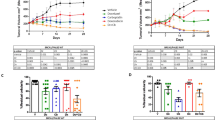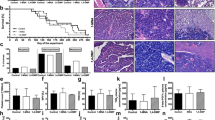Abstract
Phortress (the dihydrochloride salt of the lysylamide prodrug of 2-(4-amino-3-methylphenyl)-5-fluoro-benzothiazole (5F 203)) is an experimental antitumor agent with potent and selective activity against human-derived carcinomas of breast, ovarian and renal origin. UK clinical trials of Phortress are scheduled to begin in 2004. The mechanism of action of Phortress is distinct from all classes of chemotherapeutic agents currently in the clinic, and involves metabolic activation by cytochrome P450 (CYP) 1A1 to electrophilic species, which generate DNA adducts in sensitive tumors only. In the present study, the antitumor efficacy of Phortress has been compared with that of doxorubicin (Dox) in nine human-derived mammary carcinoma xenograft models, cultivated subcutaneously in the flanks of nude mice. In addition, cyp1a1 mRNA expression was measured in tumors of control and treated animals. Phortress compared favorably with Dox: significant activity, independent of estrogen receptor (ER) status, was established in 7/9 xenografts; in one xenograft model, Phortress elicited superior antitumor activity; no model demonstrated complete resistance to Phortress. In accordance with this observation, all xenografts available for examination (8) displayed clear induction of cyp1a1 expression upon treatment of mice with Phortress whereas Dox failed to induce cyp1a1 expression in all models. Prolonged viability of tumor fragments, recovered for treatment ex vivo could not be sustained; thus correlations between tumor cells' response to Phortress and cyp1a1 or cyp1b1 inducibility following 5F 203 treatment could not be determined with confidence.
Similar content being viewed by others
References
Bradshaw TD, Chua M-S, Browne HL, Trapani V, Sausville EA, Stevens MFG: In vitro evaluation of amino acid prodrugs of novel antitumour 2-(4-amino-3-methyl-phenyl)benzothiazoles. Brit J Cancer 86: 1348–1354, 2002
Bradshaw TD, Fichtner I, Bibby MJ, Double JA, Cooper PA, Alley MC, Tomaszewjski JE, Donahue S, Stinson SF, Sausville EA, Stevens MFG: Preclinical evaluation of amino acid prodrugs of novel antitumor 2-(4-amino-3-methylphenyl)benzothiazoles. Mol Can Therapeutics 1: 239–246, 2002
Alley MC, Stinson SF, Pacula-Cox CM, Upadhyay KB, Bradshaw TD, Chua M-S, Stevens MFG, Sausville E: A. Pharmacologic evaluations of fluorinated 2-(4-aminophe-nyl)benzothiazole analogs with unique anticancer activities. Proc AACR 44: #5166, 2000
Loaiza-Perez AI, Trapani V, Hose C, Singh SS, Trepel J, Stevens MFG, Bradshaw TD, Sausville EA: The AhR mediates sensitivity of MCF-7 breast cancer cells to the antitumor agent 2-(4-amino-3-methylphenyl)benzothiazole. Molecular Pharmacol 61: 13–19, 2002
Chua M-S, Kashiyama E, Bradshaw TD, Stinson SF, Brantley E, Sausville EA, Stevens MFG: Role of CYP1A1 in modulation of antitumor properties of the novel agent 2-(4-amino-3-methylphenyl)benzothiazole (DF 203, NSC 674495)in human breast cancer cells. Cancer Res 60: 5196–5203, 2000
Hutchinson I, Chua M-S, Browne HL, Trapani V, Bradshaw TD, Stevens MFG: Antitumor benzothiazoles. 14. The synthesis and in vitro biological properties of fluorinated 2-(4-aminophenyl)benzothiazoles. J Med Chem 44: 1446–1455, 2001
Monks A, Harris E, Hose C, Connelly J, Sausville A: Genotoxic profiling of MCF-7 breast cancer cell line elucidates gene expression modi cations underlying toxicity of the anticancer drug 2-(4-amino-3-methylphenyl)-5-fluorobenzothiazole. Mol Pharmacol 6: 766–772, 2003
Leong C-O, Gaskell M, Martin EA, Heydon RT, Farmer PB, Bibby MC, Cooper PA, Double JA, Bradshaw TD, Stevens MFG: Antitumour 2-(4-aminophenyl)benzothiazoles generate DNA adducts in sensitive tumour cells in vitro and in vivo. Brit J Cancer 88: 470–477, 2003
Guengerich FP: The Bernard B Brodie award lecture: bioactivation and detoxi cation of toxic and carcinogenic chemicals. Drug Metab Dispos 21: 1–6, 1993
Hansen LG, Shane BS, Xenibiotic metabolism. In: Cockerham LG, Shane BS (eds) Basic Environmental Toxicology, CRC Press, Boca Raton, FL, 1994, pp 49–105
Crofts FG, Sutter TR, Strickland PT: Metabolism of 2-amino-1-methyl-6-phenylimidazo [4, 5-b]pyridine by human cytochrome P4501A1, P4501A2 and P4501B1. Carcinogenesis (Lond) 19: 1969–1973, 1998
William B, Pratt WB: In: The Anticancer Drugs. 2nd edn. Oxford University Press, New York, 1994
Hutchinson I, Jennings SA, Vishnuvajjala BR, Westwell AD, Stevens MFG: Antitumor benzothiazoles. 16. Synthesis and pharmaceutical properties of antitumor 2-(4-aminophenyl)benzothiazole amino acid prodrugs. J Med Chem 45: 744–747, 2002
Soule HD, Vazquez J, Long A, Albert S, Brennan, M: A human cell line from a pleural effusion derived from a breast carcinoma. JNCI 51: 1409, 1973
Naundorf H, Fichtner I, Buttner B, Frege, J: Establishment and characterization of a new human estradiol-and progesterone-receptor-positive mammary carcinoma serially transplantable in nude mice. J Cancer Res Clin Oncol 119: 35–40, 1992
Naundorf H, Becker M, Lykkesfeldt AE, Elbe B, Neumann C, Buttner B, Fichtner I: Development and characterization of a tamoxifen resistant breast carcinoma xenograft. Brit J Cancer 82: 1844–1850, 2000
Fichtner I, Naundorf H, Saul GJ, Zschiesche W, Zeisig R: Establishment and characterization of human xenotransplanted breast carcinoma lines: use for the screening of alkylphosphocholines (APC). In: Arnold W, Kopf-Maier P, Micheel B (eds) Immunode cient Animals: Models for Cancer Research. Contrib Oncol Basel, Karger 51: 129–133, 1996
Naundorf H, Fichtner I, Elbe B, Saul GJ, Haensch W, Zschiesche W, Reinecke S: Establishment and characteristics of two new human mammary carcinoma lines in nude mice with special reference to the estradiol receptor status and the importance of stroma for in vivo and in vitro growth. Breast Cancer Res Treat 32: 187–196, 1994
Naundorf H, Fichtner I, Saul GJ, Haensch W, Buttner, B: Establishment and characteristics of two new human mammary carcinoma lines serially transplantable in nude mice. J Cancer Res Clin Oncol 119: 652–656, 1993
Shi D-F, Bradshaw TD, Wrigley S, McCall CJ, Lelieveld P, Fichtner I, Stevens MFG: Antitumor Benzothiazoles. 3. Synthesis of 2-(4-aminophenyl)benzothiazoles and evaluation of their activities against breast cancer cell lines in vitro and in vivo. J Med Chem 39: 3375–3384, 1996
Bradshaw TD, Wrigley S, Shi D-F, Schultz RJ, Paull KD, Stevens MFG: 2-(4-Aminophenyl)benzothiazoles: novel agents with selective pro les of in vitro and in vivo activity. Brit J Cancer 77: 745–752, 1998
Bradshaw TD, Chua M-S, Orr S, Matthews CS, Stevens, MFG: Mechanisms of acquired resistance to 2-(4-aminophenyl)benzothiazole (CJM 126, NSC 34445). Brit J Cancer 83: 270–277, 2000
Hose C, Hollingshead M, Sausville EA, Monks A: Induction of CYP1A1 in tumor cells by the antitumor agent 2-(4-amino-3-methyl)-5-. uorobenzothiazole: a potential surrogate marker for patient sensitivity. Mol Can Therapeutics 2: 1265–1272, 2003
Vickers PJ, Dickens RB, Shoemaker R, Cowan KH: A multidrug-resistant MCF-7 human breast cancer cell line which exhibits cross resistance to antiestrogens and hormone-independent tumor growth in vivo. Mol Endocrinol 2: 886–892, 1988
Author information
Authors and Affiliations
Rights and permissions
About this article
Cite this article
Fichtner, I., Monks, A., Hose, C. et al. The Experimental Antitumor Agents Phortress and Doxorubicin are Equiactive Against Human-Derived Breast Carcinoma Xenograft Models. Breast Cancer Res Treat 87, 97–107 (2004). https://doi.org/10.1023/B:BREA.0000041586.64371.88
Issue Date:
DOI: https://doi.org/10.1023/B:BREA.0000041586.64371.88




